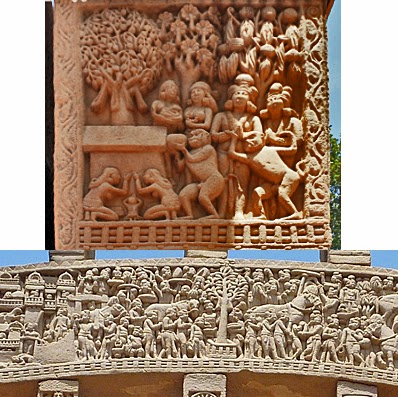I write about the process that Buddha statue was born in India.
インドで仏像が誕生した経緯をまとめます。
< 1. Priest king statue and female clay doll, Moenjo-Daro, 2600-1900 B.C. >
From the oldest iconography in India
The above statures are things of Indus civilization, and the female doll resembles slightly the clay doll of Patna Museum (right-side in Fig. 6 of this series 17).
The priest king statue has greatly deformed eyes, but let you feel dignity.
The image expression was already possible at that time.
インド最古の図像から
上図共にインダス文明のもので、女性土偶は、前回見たパトナの土偶(17話の図6の右端)に少し似ている。
神官王像は目が大きくデフォルメされてはいるが、威厳を感じさせる。
既に像表現は可能だった。
< 2. a posture of yoga >
Left fig.: a seal of Indus civilization in 2600-1900 B.C., a person performing yoga is being surrounded by sacred animals.
Right fig.: Buddha triad statue in the 2nd century. The posture of Buddha sitting down and meditating seems to have roots in Indus civilization.
左図: インダス文明の印章、紀元前2600~1900年、神聖な動物に囲まれ、ヨーガを行っている人物が描かれている。
右図: 仏三尊像、後2世紀、仏陀が座り、瞑想する行為の原点はインダス文明まで遡るようです。
< 3. lion statue of a pillar of King Asoka in Sarnath, 250 B.C. >
Although the power of expression of this statue was wonderful, these expressions of statue, construction and letter were a big blank in between Indus civilization collapse and this time.
After this time, relief engraving of King Asoka or native divine statues (Yaksi etc.) came to be made.
この動物像の表現力は素晴らしいが、インダス文明崩壊からこの時代まで、彫像や建築、文字において大きな空白があった。
この時代以降、アショーカ王の浮き彫りや土着の神像(ヤクシーなど)などは造られるようになった。
Summary
In the 3rd century B.C., King Asoka built epitaphs, king’s pillars, and stupas (Buddhism) in various parts of India, in order to encourage "law" (morality, religion).
Centering on these stupas, a trend to worship as God to Buddha who died at hundreds years ago was born (Mahayanist Buddhism).
On the other hand, a religious sect that strictly conformed to religious precepts of Buddha and searched the doctrine had separated from the people (Hinayana Buddhism).
まとめ
前3世紀、アショーカ王はインド各地に「法」(道徳、宗教)を奨励するために碑文、王柱、ストゥーパ(仏教)を造った。
このストゥーパを中心に、数百年前に死んだ仏陀を、一修行者・覚者としてではなく、神として崇拝する風潮が生まれた(大乗仏教)。
一方、仏陀の戒律を守り、その教義を探求していた教派は民衆から離れていった(小乗仏教)。
< 4. a story of Buddha in a gate of a stupa in Sanchi >
Upper fig.: a linden tree of the left corner shows Buddha.
Lower fig.: the scene shows that he rode a horse and went out left-side royal palace when Buddha was a prince. 50-25 B.C.
Before long, the relief engraving that explains a life of Buddha, miracles, and a doctrine was dedicated around these stupas.
However, people symbolized it with Buddha's foot and linden tree without first expressing Buddha.
Probably, people hesitated to express worshiped Buddha with a poor image.
Moreover, Buddha itself did not desire to be deified probably.
上図: 左隅の菩提樹が仏陀を示している。
下図: 釈迦王子が左の王宮から馬に乗って出家するシーン、馬上に釈迦は描かれていない。前50~25年頃
やがて仏陀の生涯、奇蹟、教義を説明する仏伝浮き彫りがストゥーパの回りに奉献された。
しかし、最初、仏陀を人物で表現せず、仏足や菩提樹で象徴していた。
おそらく人々は、崇拝する仏陀を粗末な像として表現することをためらったのだろう。
また仏陀自身も、神格化されることを望まなかっただろう。
Letter hadn't yet spread at that time, and many people couldn't read the sacred book of Buddhism and the story of Buddha.
Hereby, Buddha statue would also play important role for spreading Buddhism.
Before long, the produce of Buddha sculpture in the round began from relief engraving.
In Gandhara, the culture was affected by Greece, a resistance of the hesitation was few and the Greek style was adopted.
On the other hand, in Mathura, it was strong, and then Buddha statues were made by way of bodhisattva at first.
Gandhara and Mathura have influenced mutually, therefore it isn’t important which made Buddha statue in first.
Aryan Veda culture and native cultures had fused, and Greek culture of the westward stimulated it, and then Buddha statue was born.
By the degree of these influences, the difference between the both birthplaces arose.
当時、文字がまだ普及しておらず、多くの人は仏伝や経典を文字で読みことはなかった。
このことも仏像が仏教普及に重要な役割を果たすことになった。
やがて仏伝浮き彫りから、丸彫りの仏陀が造られ始めた。
ガンダーラではギリシャ文化の影響を受け、その抵抗は少なく、ギリシャ様式も取り入れられた。
一方マトゥラーでは、その抵抗が強く、仏陀を菩薩と称して造り始めた。
ガンダーラとマトゥラーは相互に影響し合ったのであって、どちらが先に仏像を造ったかは重要ではない。
アーリア人のヴェーダー文化と土着の文化が融合し、さらに西方のギリシャ文化が刺激となって仏像が生まれたと言える。
これらの影響度合いで、両発祥地での仏像様式に違いが生じた。
< 5. gold coin >
Upper fig.: gold coin of King Kanishka in the 1st - 2nd century, left shows King Kanishka, right shows Buddha.
Lower fig.: Hindu's Shiva and a bull in about the 2nd century.
The Brahmanism was stimulated by the Buddhism prosperity, and absorbed the beliefs among the natives, and the statues of Hindu god were made.
Next time, I investigate relations between Buddha statue in India and statues of god of the world.
上図: カニシカ王発行の金貨、表(左)にはカニシカ王、裏(右)には仏陀、後1~2世紀。
下図: ヒンドゥーのシバ神と牡牛、おそらく後2世紀。
バラモン教は、当時の仏教隆盛に刺激され、土俗信仰を吸収し、ヒンドゥー神像を造るようになっていた。
次回は、インドの仏像と世界の神像との関わりを見ます。





No comments:
Post a Comment